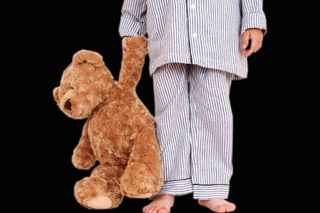
All You Need to Know About Children’s Sleep Disturbances
Stress, anxiety and an underdeveloped nervous system can cause nighttime problems.

Noah, a 4-year-old, was recently diagnosed with parasomnia, a disruptive sleep disorder that causes night terrors, sleepwalking and sleep talking.
For him, it means, “…he talks, shouts, screams, cries and laughs during his sleep,” his mother told the BBC.
Noah’s case was a serious one. When his diagnosis came through, his mother said, “It was of huge comfort to know that there was a medical reason behind his sleeplessness.”
However, many others, pay little attention to their child’s nighttime behaviors thinking, for instance, that their sleepwalking is them simply acting out their dreams or tend to brush it off as normal childhood behavior that they will eventually grow out of.
However, neither of the above are reasons behind why a child walks, talks or wakes up frightened in the middle of the night.
They occur due to the brain’s inability to regulate sleep or wake cycles because in some children this routine develops faster while some others are slower in establishing a regular cycle leading to issues with sleeping peacefully at night. In most other cases, it happens because children are overtired or anxious, says the Harvard Health Publishing (HHP), the publishing division of Harvard University’s medical school.
“Most children outgrow the symptoms as their nervous systems develop,” the HHP states. However, there is a possibility that these can last into adulthood or begin again later in life, due to a range of psychological factors that “include extreme stress or, rarely, medical causes such as epilepsy,” according to the HHP.
Related on The Swaddle:
Therefore, we try and break down each of these behaviors among children to understand why they occur and whether it is possible to manage them.
At what age do children sleepwalk or experience night terrors?
Both, sleepwalking and sleep terrors, are related and tend to run in families, reports the HHP. Both are common in school-age children. However, sleepwalking, also known as somnambulism, is more common among boys.
Nationwide Children’s, an academic pediatric medical center estimates about 15% of children between ages five and 12 walk in their sleep, a behavior also frequently associated with bedwetting at night.
Children usually stop sleepwalking during adolescence. In a small percentage of people, it may continue beyond puberty, the HHP states.
Sleep terrors, on the other hand, are most common in children between the ages one and eight, however, they may begin as early as six months and occasionally last into adulthood.
How do children behave if they are sleepwalking or experiencing night terrors?
When sleepwalking, children walk or make movements that seem purposeful. This means they could be sitting up or getting out of bed, eating, dressing, undressing or urinating. Their eyes are open and they will often exhibit blank expressions and are in a state that is difficult to awaken them from.
Sleep or night terrors is a disorder in which a person wakes up quickly in an extremely frightened state, as described by the HHP. Behaviors often exhibited by children when experiencing a night terror include thrashing out violently, breathing heavily or having a rapid heart rate and being unaware of the surroundings. They are also likely to exhibit intense fear or agitation, maybe sweating, screaming or crying about someone’s presence in the room.
Related on The Swaddle:
Sleep Quality, Not Just Quantity, Linked to Childhood Obesity
How long do these episodes usually last?
Sleepwalking and night terrors can occur an hour or two into sleep and last up to half an hour, according to the HHP. A sleep terror episode may last for 10 to 20 minutes. As the disturbance subsides, the child returns to deep sleep, it adds. And children won’t remember experiencing any of these the next morning. This is how night terrors are different from nightmares.
Do these conditions need medical attention?
Usually, the conditions don’t require treatment unless it is a difficult case. For instance, if the frequency is high or their episodes are very severe where the sleepwalker is often ending up injured It will also be considered serious if there are instances of them leaving the house or if a child is exhibiting these behaviors beyond puberty. If this is the case, then one may need to consult a sleep specialist or a pediatrician.
What to do when children sleepwalk or wake up frightened in the middle of the night?
If the episodes do not match any of the criteria mentioned above for them to be qualified as severe, certain preventive measures should suffice to manage them. These include providing children with a “relaxing bedtime routine with an early bedtime to help prevent sleep disturbances,” as stated by the HHP.
If the child is sleepwalking, gently leading them back, without trying to wake them up (you won’t be able to), to bed is an ideal step. If they are experiencing night terrors, reassuring them with statements such as, “You are safe,” “You are home in your own bed,” are useful for calming them down.
HHP mentions a technique called prompted awakenings that may help to prevent future episodes in children with frequent sleepwalking or night terrors. “For several nights, record the length of time between when the child falls asleep and the sleepwalking or night terrors begin. Then for seven nights in a row, awaken the child 15 minutes before the expected time of the episode. Tell the child at bedtime that you will try to wake him or her quickly. Keep the child fully awake for 5 minutes.”
Related on The Swaddle:
The Basics of Kids’ Sleep and Bedtimes by Age
What is sleeptalking?
Sleepwalking and sleep terrors are also both symptoms of another condition known colloquially as sleep talking and medically as somniloquy. It is a sleep disorder defined by the National Sleep Foundation (NSF) as talking during sleep without being aware of it.
What are the characteristics of sleep talking?
“Sleep talking can involve complicated dialogues or monologues, complete gibberish or mumbling. The good news is that for most people it is a rare and short-lived occurrence. Anyone can experience sleep talking, but the condition is more common in males and children,” says the NSF.
At what stage of sleep does a child sleeptalk?
It can occur during any stage of sleep. The lighter the sleep, the more intelligible the speech, says the NSF. If sleeptalk was divided into stages, it says that in stages 1 and 2, people can have entire conversations and in 3 and 4, it may be restricted to moans and gibberish. Its symptoms can vary in severity and duration.
While mild episodes are those that occur less than weekly, sleep talking episodes occur moderately if they happen more than once a week and are qualified as severe if they happen every night.
Does sleeptalking require treatment?
“In general, no treatment is necessary. However, if sleep talking is severe or persists over a long period of time, talk to your child’s physician or health care provider about the problem,” the NSF advises. “There may be an underlying medical explanation for your sleep talking (e.g. an undiagnosed sleep disorder, or debilitating anxiety or stress).
Anubhuti Matta is an associate editor with The Swaddle. When not at work, she's busy pursuing kathak, reading books on and by women in the Middle East or making dresses out of Indian prints.
Related


Alcohol Abuse Is a Spectrum; From Social Drinking to High‑Functioning Alcoholism
